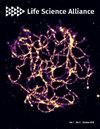COVID-19 患者自身抗体分泌浆细胞的克隆分布。
IF 3.3
2区 生物学
Q1 BIOLOGY
引用次数: 0
摘要
虽然严重的 COVID-19 常常与自身抗体滴度升高有关,但其产生的内在机制仍不清楚。在这里,我们报告了在对SARS-CoV-2的体液反应中自身抗体的克隆组成和多样性。通过对浆细胞衍生的单克隆抗体进行免疫球蛋白谱系分析和特征描述,我们发现了产生心磷脂(CL)反应性自身抗体的浆细胞的克隆扩增。在扩增的CL反应克隆中,有一半与SARS-CoV-2抗原有很强的结合力。其中一个克隆 CoV1804 对 CL 和病毒核壳(N)均有反应,并在人体细胞中进一步显示出抗核仁活性。值得注意的是,在 COVID-19 患者来源的免疫球蛋白中发现了与 CoV1804 具有相同遗传特征的抗体,从而构成了一种新型公共抗体。这些公共自身抗体有许多突变,明确增强了抗 N 反应性,同时导致抗 CL 反应性波动,并在后代中获得额外的自身反应性,如抗核极活性。因此,潜在的CL反应性前体可能是在病毒抗原的驱动下,通过克隆选择、扩增和体细胞超突变形成了多种自身反应性。我们的研究结果揭示了 COVID-19 期间自身抗体产生的本质,并为病毒诱导的自身抗体的起源提供了新的见解。本文章由计算机程序翻译,如有差异,请以英文原文为准。
Clonal landscape of autoantibody-secreting plasmablasts in COVID-19 patients.
Whereas severe COVID-19 is often associated with elevated autoantibody titers, the underlying mechanism behind their generation has remained unclear. Here we report clonal composition and diversity of autoantibodies in humoral response to SARS-CoV-2. Immunoglobulin repertoire analysis and characterization of plasmablast-derived monoclonal antibodies uncovered clonal expansion of plasmablasts producing cardiolipin (CL)-reactive autoantibodies. Half of the expanded CL-reactive clones exhibited strong binding to SARS-CoV-2 antigens. One such clone, CoV1804, was reactive to both CL and viral nucleocapsid (N), and further showed anti-nucleolar activity in human cells. Notably, antibodies sharing genetic features with CoV1804 were identified in COVID-19 patient-derived immunoglobulins, thereby constituting a novel public antibody. These public autoantibodies had numerous mutations that unambiguously enhanced anti-N reactivity, when causing fluctuations in anti-CL reactivity along with the acquisition of additional self-reactivities, such as anti-nucleolar activity, in the progeny. Thus, potentially CL-reactive precursors may have developed multiple self-reactivities through clonal selection, expansion, and somatic hypermutation driven by viral antigens. Our results revealed the nature of autoantibody production during COVID-19 and provided novel insights into the origin of virus-induced autoantibodies.
求助全文
通过发布文献求助,成功后即可免费获取论文全文。
去求助
来源期刊

Life Science Alliance
Agricultural and Biological Sciences-Plant Science
CiteScore
5.80
自引率
2.30%
发文量
241
审稿时长
10 weeks
期刊介绍:
Life Science Alliance is a global, open-access, editorially independent, and peer-reviewed journal launched by an alliance of EMBO Press, Rockefeller University Press, and Cold Spring Harbor Laboratory Press. Life Science Alliance is committed to rapid, fair, and transparent publication of valuable research from across all areas in the life sciences.
 求助内容:
求助内容: 应助结果提醒方式:
应助结果提醒方式:


